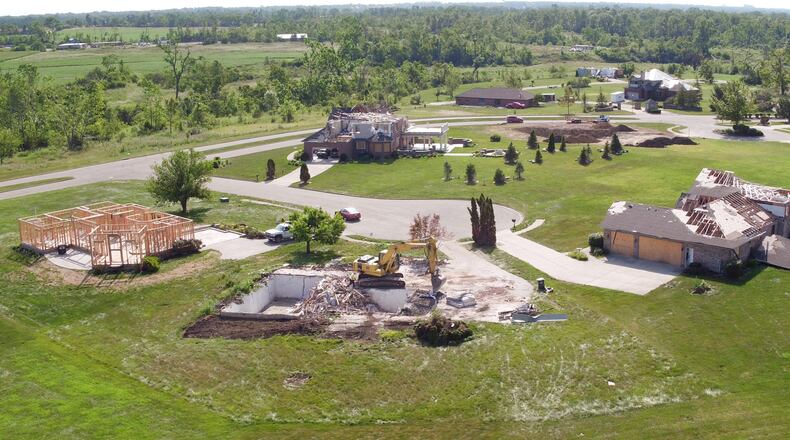After analyzing 14,000parcels in the tornadoes’ paths, the Montgomery County Auditor’s Office released the map last week showing 4,434 properties had been affected to some degree, 913 destroyed or with major damage.
INTERACTIVE MAP: See where thousands of properties were damaged in Montgomery County tornadoes
The map was needed “like yesterday,” said Amy Radachi, the acting chair of the housing coalition of the Miami Valley Long-Term Recovery Operations Group.
“To be able to target specific neighborhoods that have been impacted would have the most effect for the survivors,” said Radachi, president and CEO of Rebuilding Together Dayton, one of four area nonprofits organized to help those without insurance or short on FEMA funds as they rebuild and repair housing.
“A map like this will help align all of our rebuilding efforts in a way that would make the most sense,” she said.
Each coalition group focuses on a different aspect of housing and each has its own income and age criteria. The map will allow them to determine which organization is best positioned to take on a rebuilding or repair job based on the circumstances and needs of the homeowner or prospective owner, Radachi said.
“This will alleviate the necessity of having to literally go door-to-door to find the appropriate project,” she said.
MORE: Local tornado victims slow to get FEMA aid approval
Worse than first thought
Harrison Twp. Administrator Kris McClintick knew his township took the brunt of an EF-4 tornado, figuring about 10% of its properties were affected. On Thursday, the county auditor gave him a more precise figure, one higher than he imagined.
The survey showed 1,850 properties in the township were damaged, or 15% of all township parcels. The number reflected 42% of all affected properties in the county.
“That’s going to impact our tax base,” McClintick said. “Our funds were healthy, but we didn’t have a lot of extra money.”
Montgomery County Auditor Karl Keith said it’s too soon to estimate the losses faced by local jurisdictions, schools, Five Rivers MetroParks, Dayton Metro Library and other entities.
“From an auditor’s office perspective, we know that property values and local tax revenues will be significantly impacted,” Keith said. “This is going to have a long-term impact, particularly in communities like Trotwood and Harrison Twp. and the school districts in those areas.”
MORE: Busing issues, building repairs plague school districts after tornadoes
Trotwood received about $8.2 million generated from property taxes in 2018 while collections of about $4 million went to Harrison Twp., according to the county auditor’s office.
A clearer picture of future tax revenues should emerge by the end of the year, Keith said. Appraisers are in tornado-affected areas now conducting field checks and property owners with tornado damage have until the end of the month to sign up for a program to have tax values lowered.
While the map shows 89% of the affected properties to be residential, nearly half of the 387 commercial properties affected were in Harrison Twp. And a greater percentage of property taxes — 46% — comes from commercial and industrial properties in Harrison Twp. compared to 27% in Trotwood.
“Those are some large, individual tax-base properties that we will definitely feel the impact of with reduced revenue,” McClintick said.
PHOTOS: Tornado outbreak in Miami Valley
Many of the affected Harrison Twp. businesses plan to rebuild, he said. Because tax payments are a year in arrears, the loss to jurisdictions won’t be felt immediately, he said. But the effects will come.
“Those two to three years of temporary tax base reductions are going to certainly impact our bottom line and service delivery. We just don’t know how yet,” McClintick said.
Aid to those who need it
Since the county released the information Thursday, groups working on recovery operations have sought the data, including the cites of Dayton and Trotwood, the Miami Valley Regional Planning Commission and a couple of Montgomery County divisions including Human Services.
Radachi also requested the information from the auditor. She said the organizations have received suspect requests for repair assistance from property owners clearly outside the damage zones of the tornadoes.
MORE: Community-by-community assessment of tornado damage: What they are saying
The technology the auditor’s office used — a comparison of aerial photos taken in March to those taken within a week following the tornadoes — can also help distinguish tornado damage from what might be deferred home maintenance, Radachi said.
She said it was helpful “to have some official reporting of where the actual impact was.”
But behind the numbers are thousands of property owners and hundreds who will legitimately need more help to recover, Keith said.
“I don’t think we should lose track that it’s tragic from an individual’s point of view — the person who has lost their home or who’s lost their business or their job as a result,” he said.
About the Author

